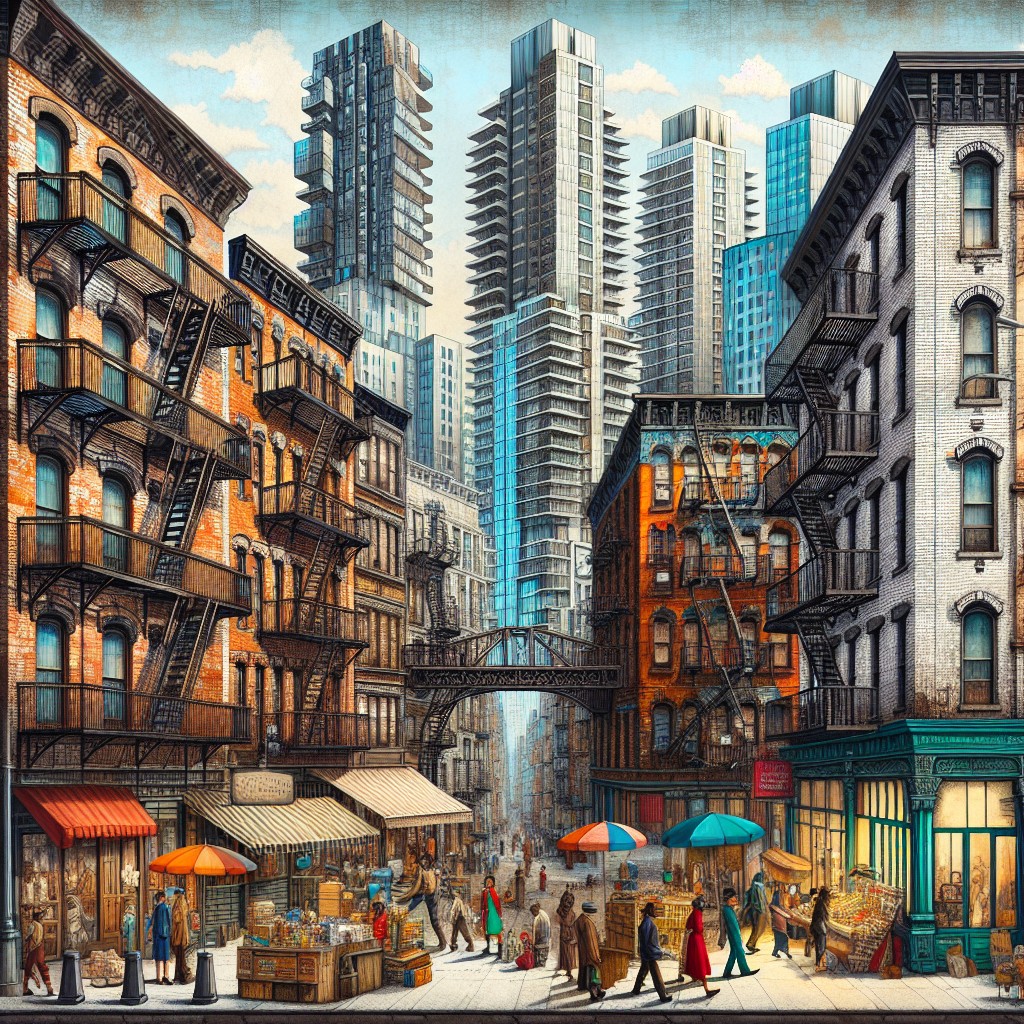Last updated on
Diving into the compelling history of New York, this post will reveal why the iconic neighborhood known as Hell’s Kitchen got its fiery nickname.
Key takeaways:
- Hell’s Kitchen is located on the West Side of Manhattan.
- The nickname may have originated from the area’s tough reputation.
- It could also be due to the fiery industrial landscape at the time.
- The Hell’s Kitchen Gang and a small riot anecdote add to the theories.
- Hell’s Kitchen is known for its cultural diversity and contribution to the arts.
What's Inside
Hell’s Kitchen’s Location and Development

Nestled on the West Side of Manhattan, stretching approximately from 34th to 59th Street and bordered by Eighth Avenue and the Hudson River, Hell’s Kitchen has undergone an incredible transformation over the years. Historically a bastion for immigrants and the working class, this neighborhood has evolved from its gritty beginnings into a vibrant community brimming with restaurants, theaters, and a diverse mix of residents.
Driven by successive waves of urban development and regeneration, high-rise luxury living complexes now punctuate its once low-rise skyline. Despite this growth, remnants of its rough-and-tumble past pepper the area with a unique charm, merging old New York with new developments and creating an urban mosaic unlike any other.
Origin and Theories: Facts and Fiction
Sorting through the labyrinth of stories behind the notorious moniker reveals a blend of gritty truths and embellished tales. One popular theory suggests that the name sprung from the area’s notoriously tough reputation in the 19th century, where it was a melting pot of crime and poverty. Police officers and locals allegedly compared the neighborhood to the infernal chaos of Hell, hence the striking comparison.
Another narrative points to the fiery industrial landscape of the time. The flames from the gasworks, breweries, and factories illuminated the skyline, creating a hellish vista for those in the surrounding areas. It’s these very flames that some believe led to the neighborhood’s vivid epithet.
Conversely, there are suggestions that the name originated from a notorious tenement on 54th Street where a gang known as “The Hell’s Kitchen Gang” resided, further cementing the area’s association with lawlessness and vice.
Delving into the area’s culinary history, you may also stumble upon a whimsical fiction that Hell’s Kitchen got its name from two cops watching a small riot. According to this anecdote, one cop remarked that the scuffle was “hot as hell’s kitchen,” and the name stuck.
However credible each story may be, they collectively paint a picture of a neighborhood that, while once rough around the edges, has undeniably influenced the colorful lexicon of New York City’s diverse urban landscape.
Hell’s Kitchen and Culture
The cultural tapestry of this neighborhood is rich and varied, reflecting its storied past. Notably, Hell’s Kitchen has been a melting pot of immigrants, initially Irish and later a diverse mix including Greek, Mexican, and Puerto Rican communities, each contributing customs, cuisines, and celebrations.
The arts have flourished here, partly thanks to its proximity to the Theatre District. This has drawn countless aspiring actors, musicians, and artists, infusing the area with creative energy. The famed Actor’s Studio helped shape method acting here.
Furthermore, Hell’s Kitchen has found its way into popular culture, providing a gritty backdrop for numerous films and television shows, epitomized by Marvel’s Daredevil. The neighborhood’s resilience and transformation over time are often mirrored in the themes of these works, influencing the American vision of urban revival and community resilience.
The Term “Hell’s Kitchen” Was First Used By Davy Crockett
Davy Crockett’s usage of the term in the 1830s isn’t linked to the mid-19th-century Irish gangs or the rough-and-tumble reputation of the post-Civil War era that the neighborhood became notorious for. Instead, his reference was a metaphor. Crockett, a statesman and folk hero, was expressing dismay over a different part of New York City in his 1835 account of a visit. His purpose was to lament the living conditions and the inhabitants’ struggles.
The actual label for the Manhattan neighborhood would arise independently, coined by local police and reporters who witnessed the area’s descent into poverty and crime in the latter half of the 19th century.
This disconnection poses an interesting case in the evolution of urban place names — how similar descriptors can arise at different times and contexts, yet only one becomes rooted to a location. The term “Hell’s Kitchen,” as it pertains to the Manhattan neighborhood, therefore owes less to Crockett’s rhetoric and more to the later prevailing conditions and the colorful vernacular of journalists looking for a vivid way to depict an area that was, at the time, nearly lawless.
The Neighborhood in New York City, “Hell’s Kitchen,” Was Called That Due to Journalists Using the Term
The moniker “Hell’s Kitchen” for the New York neighborhood is more than just a vivid epithet. It sprung from the gritty reality of the area in the mid-to-late 19th century, when it was known for poor living conditions, crime, and a generally rough atmosphere.
Journalists, observing the mayhem that was as intense as a cauldron of chaos, began referring to the area in print with this evocative name, effectively branding the neighborhood.
Here are several points explaining why journalists gravitated towards this particular term:
- Reflection of Reality: The name was a reflection of the extreme poverty, violence, and vice that were rampant in the area. It was a place that seemed as unruly and tumultuous as the underworld itself.
- Vivid Imagery: “Hell’s Kitchen” conjures powerful images of fire and brimstone, serving as an instant metaphor for the dangerous lifestyle and gang activity of the area, which was akin to a war zone at the time.
- Sensationalism: Sensational headlines are known to sell newspapers. The shocking moniker would draw readers’ attention, playing to the human fascination with dark or edgy stories.
- Theater of Life: For journalists, the neighborhood provided a rich tapestry of stories and characters that could be portrayed as part of a larger ‘theater of life’ in a booming metropolitan city.
- Historical Stigma: Once the name was cemented through repeated use in the media, it perpetuated the neighborhood’s nefarious reputation, even as conditions began to improve in subsequent decades.
Understanding why the press played such a pivotal role in branding this neighborhood can provide insight into the powerful influence media has over public perception and how a name can shape the identity of a place for generations to come.




